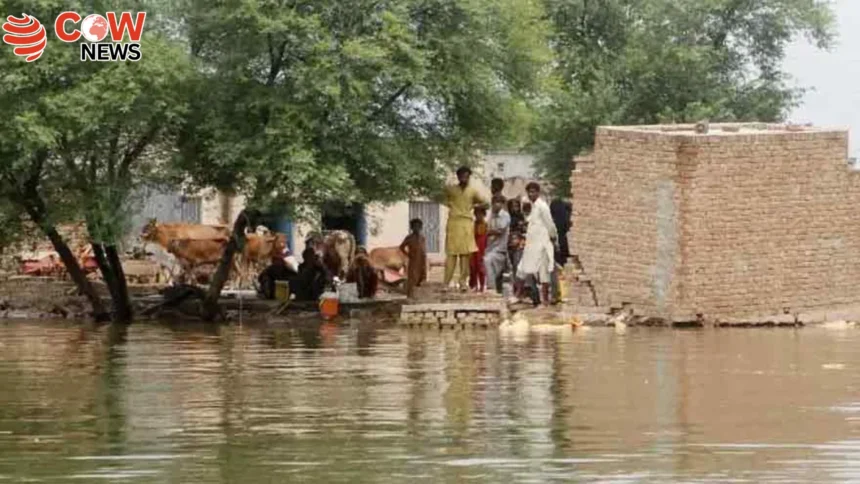MULTAN ( The COW News Digital) – Flood devastation continues to escalate across Punjab and Sindh, with major rivers breaching embankments and displacing millions.
The implications of rising waters from the Indus River extend far beyond immediate flooding. Historically, regions along the river have experienced cycles of flooding that not only reshape the landscape but also influence agricultural patterns, local economies, and community resilience. For example, in 2010, devastating floods affected millions, highlighting the need for improved infrastructure and disaster preparedness.
Moreover, the rise in water levels can disrupt local ecosystems, leading to challenges such as habitat loss and changes in fish populations, which are vital for the livelihoods of many local communities. Understanding these ecological impacts is crucial for effective flood management strategies that also consider environmental sustainability.
As the situation escalates, understanding the Indus river swells and flood threat in sindh becomes increasingly vital for communities living in vulnerable areas.
With the expected increase in extreme weather patterns due to climate change, the need for adaptive strategies becomes even more pressing. Local governments, along with national agencies, are exploring innovative approaches such as floodplain restoration and enhanced forecasting systems to better predict and manage flood risks.
Rising waters from the Indus River at Guddu Barrage have now triggered a high-level flood warning, with downstream areas at imminent risk.
The floodwaters are now surging south toward Sindh. The province, which faced catastrophic flooding in 2022, is once again under threat. The Indus River at Guddu Barrage is seeing flows rise to 537,000 cusecs—classified as a high-level flood. By September 15, extremely high flood conditions are expected.
Community engagement plays a pivotal role during these crises. Local workshops can educate residents about preparing for floods, creating emergency plans, and understanding the importance of floodplain management. This proactive approach fosters resilience and empowers individuals to take charge of their safety.
In addition, mental health support is often overlooked during these times of crisis. The stress associated with displacement and loss can have lasting effects on community well-being. Initiatives providing psychological support can help mitigate the emotional toll of flooding.
As floodwaters threaten various regions, the government may also consider implementing better drainage systems and constructing barriers designed to withstand extreme flooding. These infrastructural improvements take time and resources, but they are essential for long-term safety and security.
Furthermore, the role of NGOs and international organizations becomes critical in providing aid and resources during flooding emergencies. Collaborative efforts can ensure that the affected communities receive timely assistance, including food, medical care, and shelter.
Historically, past floods have sparked discussions on the need for better urban planning. Cities built along the riverbanks must reconsider development strategies that prioritize flood resilience without compromising growth.
As communities grapple with the potential consequences of rising water levels, it is important to remember that floods can also create opportunities for ecological restoration. Flooded areas may rejuvenate soil nutrients, which could benefit future agricultural cycles if managed correctly.
Looking forward, scientists are analyzing data trends to predict future flooding scenarios. By understanding historical patterns and current conditions, they can better inform policy decisions and community preparedness programs.
In conclusion, the challenges posed by the Indus river swells and flood threat in Sindh require a multifaceted approach involving local communities, governments, and organizations. As we brace for potential floods, it is crucial to strengthen our responses and build a more resilient future.
The situation concerning the Indus river swells and flood threat in Sindh is being monitored closely by authorities.
This year, the Indus river swells and flood threat in Sindh have raised concerns among local communities.
Water levels are also increasing at Sukkur and Kotri Barrages, with Sukkur recording inflows of 460,000 cusecs and a low-level flood at Kotri. In Rajanpur and Chachran Sharif, water levels continue to rise, reaching 11.4 feet.
As the Indus river swells and flood threat in Sindh continues, the government is taking precautionary measures.
The flood surge from Head Panjnad has reached Kot Mithan, intensifying the crisis in nearby katcha areas.
Residents are urged to stay alert due to the Indus river swells and flood threat in Sindh.
Flood relief measures are being discussed in response to the Indus river swells and flood threat in Sindh.
Although the flow at Head Panjnad has decreased to 633,000 cusecs, it remains at an extremely high flood level. In Ali Pur’s katcha region of Malan Wali, residents have been forced to relocate due to encroaching waters.
Assistance is being mobilized as the Indus river swells and flood threat in Sindh worsens.
The community is coming together to address the challenges posed by the Indus river swells and flood threat in Sindh.
In Punjab, the River Chenab has already caused widespread destruction in Jalalpur Pirwala and has now moved towards Shujabad. A 250-foot breach in a protective embankment near Shujabad has allowed floodwaters to advance toward the city, submerging dozens of villages and forcing thousands to flee their homes.
In the village of Dhowandho, a collapsed embankment has resulted in 138 settlements being submerged. Crops in Basti Ga Garan have been completely destroyed, and mass displacement is ongoing.
The situation remains dire in the suburbs of Alipur and Sitpur, where thousands of acres of farmland have been inundated. In Liaqatpur, 21 villages have been directly impacted by the floodwaters.
n village 86-M near Jalalpur Pirwala, a rescue operation has been completed under the supervision of Punjab’s senior minister, Maryam Aurangzeb. However, other areas such as Bahawalpur, Dunyapur, and Shehr Sultan report dire shortages of food and clean water. Over 100 villages in Bahawalpur’s rural belt are currently underwater.
In Lodhran, two protective dikes failed, leading to the inundation of populated areas. Rescue operations using drones were deployed to extract stranded residents.
Overall, the recent floods in Punjab have affected nearly 5,000 villages, with over 100 fatalities confirmed.
More than 4.5 million people across the province have been impacted, with over 2.45 million evacuated to safer areas.
Ultimately, the situation surrounding the Indus river swells and flood threat in Sindh necessitates ongoing vigilance and adaptive strategies to mitigate risks and promote recovery. The experiences of those impacted by flooding can inform future policies and ensure that communities are better prepared for what lies ahead.







